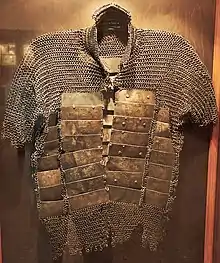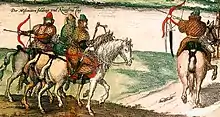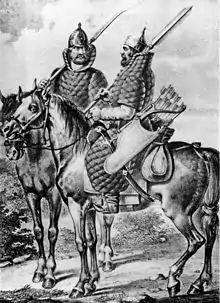The armies of the Rus' principalities emerged in the 13th century out of the military of Kievan Rus', shattered by the Mongol invasion of Kievan Rus'. The princely Rus' armies from 1240 to 1550 were characterised by feudalism, consisting of cavalry armies of noble militia and their armed servants.
Before the Mongol invasion
Before Mongol invasion of Kievan Rus' in the 13th century, a Rus' prince would be accompanied by his druzhina, a small retinue of heavy cavalry,[1] who would often fight dismounted (eq. Battle on the Ice). Massively heavy armor was used, mostly Scandinavian-style.[2] However, these squads, as a rule, did not exceed the number of several hundred men, and were unsuitable for united actions under a single command.[3]
At the same time, the main part of the Kievan Rus' army was the militia infantry. It was inferior to Druzhina in armament and the ability to own it. The militia used axes and hunting spears ("rogatina"). Swords were rarely used, and they had no armor other than plain clothes and fur hats.[1]
For the infantry, consisted of poorly armed peasants and tradesmen, numbers are uncertain. The only specific numbers mentioned for the Rus are 1,700 men of Evpaty Kolovrat[4] (The Tale of the Destruction of Ryazan) and 3,000, men under Voivode Dorozh [5] (Battle of the Sit River). However, these were exceptionally large numbers for Rus standards at the time. In 1242, Prince Alexander Nevski in Novgorod could muster no more than 1,000 Druzhina and 2,000 militia for the Battle on the Ice.[6]
Feudal fragmentation

After Mongol invasion of Kievan Rus' many independent principalities were destroyed. Remaining petty states were under growing pressure from Tatars, Sweden and Lithuania. Constant warfare precipitated the development of feudalism, and diminished the importance of the Veche.[7] The feudal militia, raised by the Boyars-landowners and individual princes, came to replace popular militia. Princes (except in the Novgorod Republic) gathered and commanded the army.
In the second half of the 14th century, Druzhina was replaced by feudally organized units headed by Boyars or dependent Princes, and these units consisted of landed gentry (so called "Boyar's children" or "service people") and their armed servants ("military slaves"). In the 15th century, such organization of detachments replaced the city regiments.
Tactics and equipment

During the period of the Mongol invasions, the Rus adopted much of Mongol military tactics and organization. While militia infantry still existed, they were, from XIV onward, mostly armed with ranged weapons, and delegated auxiliary duties, such as defending cities. The chronicles describe the Muscovites using arquebuses against the Tatars in 1480.[8] The men shooting these weapons were the forerunners of the Streltsy.
The bulk of the army were mounted archers,[8] who included Boyars, landed gentry ("Boyars' children") and armed slaves.
Under Tatar influence, the mail and lamellar armour of Kievan Rus' was replaced with brigandine ("Kuyak"), mail and plate ("Behterets") and mirror armour("Zertsalo"),[9] while poor noblemen and armed serfs wore long aketons ("Tyegilyai").
Military of Novgorod
Landed Army of Muscovy
In the 15th century, the Grand Duchy of Moscow gradually conquered and annexed the northeastern Rus' principalities. This process is associated with reforming the Muscovite army, as new princedoms were absorbed, courts of independent princes were dismissed, and "service people" passed to the grand duke. As a result, the vassal princes and boyars were transformed into state servants, who received estates for service in conditional holding (less often - in fiefdom). Thus, the "Landed Army" (Russian: Поместное войско) was formed, the bulk of which were noblemen and "boyar's children", with their armed slaves. This army organization would remain unchanged till 1550 (military reforms of Ivan the Terrible).
In the process of Muscovite state-building, the people's militia was abolished. The prince called the masses to military service only in the event of serious military danger, regulating the extent and nature of this service at his own discretion.
Gallery
 Armed servants in aketons.
Armed servants in aketons. Warriors in aketons.
Warriors in aketons. Nobleman in brigandine.
Nobleman in brigandine. 17th-century Russian mirror armour.
17th-century Russian mirror armour.
References
- 1 2 Borisovich), Shirokorad, A. B. (Aleksandr; Борисович), Широкорад, А. Б. (Александр (2004). Rusʹ i Orda. Moskva: Veche. ISBN 5953302746. OCLC 56858783.
{{cite book}}: CS1 maint: multiple names: authors list (link) - ↑ The Cambridge history of Russia. Perrie, Maureen, 1946-, Lieven, D. C. B., Suny, Ronald Grigor. Cambridge: Cambridge University Press. 2006. pp. 54. ISBN 9780521812276. OCLC 77011698.
{{cite book}}: CS1 maint: others (link) - ↑ Grigorʹevič., Hrustalev, Denis (2017). Rusʹ i mongolʹskoe našestvie : 20--50-e gg. XIII v. Sankt-Peterburg: Evraziâ. ISBN 9785918521427. OCLC 1003145949.
{{cite book}}: CS1 maint: multiple names: authors list (link) - ↑ "Никифоровская летопись. Никифорівський літопис. Том 35. Литовсько-білоруські літописи". litopys.org.ua. Retrieved 2018-03-17.
- ↑ "Новгородская летопись". krotov.info. Retrieved 2018-03-17.
- ↑ Nicolle, David (1996). Lake Peipus 1242 : battle of the ice. London: Osprey Military. ISBN 9781855325531. OCLC 38550301.
- ↑ The Cambridge history of Russia. Perrie, Maureen, 1946-, Lieven, D. C. B., Suny, Ronald Grigor. Cambridge: Cambridge University Press. 2006. ISBN 9780521812276. OCLC 77011698.
{{cite book}}: CS1 maint: others (link) - 1 2 The Cambridge history of Russia. Perrie, Maureen, 1946-, Lieven, D. C. B., Suny, Ronald Grigor. Cambridge: Cambridge University Press. 2006. pp. 218. ISBN 9780521812276. OCLC 77011698.
{{cite book}}: CS1 maint: others (link) - ↑ "MEDIEVAL RUSSIAN ARMOR". www.xenophon-mil.org. Retrieved 2018-03-20.
- ↑ Порфиридов, Н.Г. (1947). Древний Новгород. Очерки из истории русской культуры XI–XV вв (in Russian). Издательство Академии Наук СССР. p. 122.
- ↑ Быков, А. В. (2006). Новгородское войско XI–XV веков (диссертация) (in Russian). pp. 83–109.
- ↑ Подвальнов Е.Д.; Несин М.А.; Шиндлер О.В (2019). "К вопросу о вестернизации военного дела Северо-Запада Руси". История военного дела: исследования и источники (in Russian). VII: 81. Retrieved 13 August 2022.
- ↑ Быков, А. В. (2006). Новгородское войско XI–XV веков (диссертация) (in Russian). p. 212.
- ↑ Шмелев К.В. (2001). "О применении судовой артиллерии на северо-западе России в допетровское время". Вестник молодых ученых: Исторические науки (in Russian). 1: 53–55.
Bibliography
- Perrie, Maureen (2006). The Cambridge history of Russia. Cambridge University. ISBN 9780521812276.